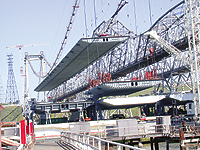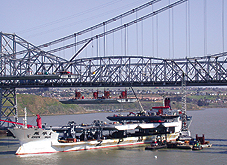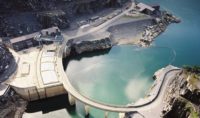 |
| UNIQUE Combo of strand jacks, trestles and skids set orthotropic deck sections. (Photo courtesy of FCI ) |
Completion of 83 days of work last month by the joint venture team of FCI Constructors Inc. and Cleveland Bridge California Inc. kicked off the final phase of construction for the 2,390-ft-long bridge, which will span the Carquinez Straits on Interstate 80 between Crockett and Vallejo. The project is on track for an October opening, says Curtis Weltz, project manager for FCI/Cleveland Bridge.
The use of strand jacks in bridge construction has been done before, says Brian Boal, a senior bridge engineer for the California Dept. of Transportation. "But not 600-ton complete orthotropic deck units swinging up onto suspension bridges," he says. The orthotropic deck is the first in the U.S. (ENR 12/24/01 p. 12).
The bridges location next to a 76-year-old cantilevered steel truss bridge slated for demolition made use of a gantry mounted on the main cable impractical, says Mark Allison, project engineer for FCI/Cleveland Bridge. "Normal lifting schemes could not be used, and therefore we had to come with hybrid lifting schemes," Allison says, because the old and new bridges are located only 40 ft apart at the northern anchorage and 60 ft in mid-channel.
For efficiency, the contractors decided to erect the 95-ft-wide deck in 24 sections rather than 48 as originally specified. Cutting the number of sections in half will minimize deck welding and save about $1 million, says Weltz.
The decision to use larger sections, which range from 79 to 163 ft in length and 520 to 800 metric tons in weight, required extensive followup design analysis, says Dyab A. Khazem, lead project engineer in the New York City office of Parsons Transportation Group. The scheme concentrated the loads far more than if a gantry had been used, Khazem says, doubling stresses on the temporary clamps to over 2,000 kilonewtons, for example.
Strand jacks with a 290-metric-ton capacity proved to be key. Four jacks were mounted on each deck section and attached to temporary strands suspended from the main cable. To maintain a 12-in. tolerance as each unit was raised, tugboats stabilized the ships carrying the deck, Allison says.
For direct vertical lifts, which constituted about half of the total, the sections were raised about 100 ft to their final positions, where they were connected to permanent suspenders. Once a section was in place, the jack assembly, generator, and other equipment were lowered onto a ship below so it could be loaded onto the next section.
 |
|
NEW Bay Area crossing is first U.S. suspension bridge built in years. (Photo courtesy of FCI ) |
Other lifts proved more complex. Two sections closest to the northern anchorage were too far inland to be reached directly by ship. Instead, each section had to be unloaded from a barge and raised 150 ft onto the embankment, where it was placed onto a 300-ft-long reinforced concrete pad equipped with rollers. Moving these segments into position took up to 10 days, says Allison.
Near the south tower, deck sections were lifted onto specially constructed skids on top of a 600-ft-long trestle. Each section was mounted on walking jacks and strands were attached at 45° angles. The unit moved forward until the angled cables gradually became vertical. The process was repeated until the section reached its final position, Allison says.
arking a milestone for the first suspension bridge to be built in 30 years in the U.S., a contractor has successfully completed what project officials call an unprecedented combination of schemes to lift, swing and roll 24 orthotropic deck sections into place. Officials say that the unusual combination of strand jacks, trestles, skids, and other equipment will offer about $1 million in cost savings and flexibility on the $217-million Alfred Zampa Memorial Bridge north of San Francisco.

Post a comment to this article
Report Abusive Comment